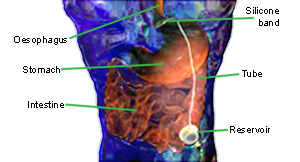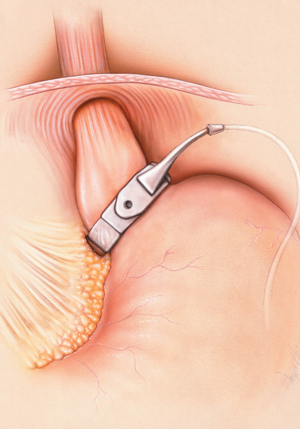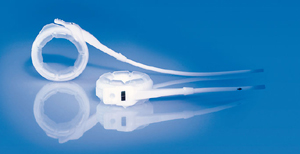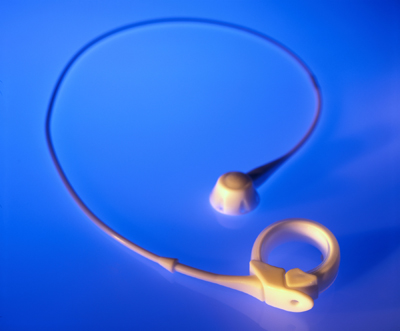- What is the LAP-BAND System?
- How does the LAP-BAND System work?
- Who is a candidate to have the LAP-BAND Adjustable Gastric Banding system?
- How effective is the LAP-BAND System?
- What are the benefits of the LAP-BAND System?
- What are the potential side effects of the LAP-BAND System?
What is the LAP-BAND System?
The LAP-BAND System, otherwise known as Lap Band or Lapband, is a device that can be placed around the first part of the stomach during “key-hole” (laparoscopic) surgery for weight loss. The device is actually an adjustable band made of flexible, silicone material. A thin tube connects the band to a port placed under the abdominal skin at the time of surgery. The port allows a surgeon to inflate or deflate the band around the stomach without further surgery, and hence maximise a person’s weight loss following the procedure.

How does the LAP-BAND System work?
The LAP-BAND System (Lap Band) works by forming a small pouch before food passes into the main stomach. This pouch holds less solid food than the stomach, so it makes the person feel “full” earlier. Food in the pouch is emptied more slowly than from the stomach, so the person may also feel “full” for longer following a meal.
The effectiveness of the system does require modification of a person’s diet. In particular, high-energy drinks (such as protein shakes, smoothies, meal replacements) should be avoided because they pass straight through the small pouch and do not cause the sense of fullness that leads to weight loss.


Who is a candidate to have the LAP-BAND Adjustable Gastric Banding system?
There are a number of factors to consider when deciding if this procedure is appropriate. The major indication for laparoscopic banding surgery is for morbidly obese patients to lose weight. The following are some of the main criteria are used to assess if the LAP-BAND System (Lap Band) is appropriate:
- Body Mass Index (BMI) of more than 40. The normal BMI is 18.5 – 24.9. Calculate your BMI here.
- BMI of more than 35 with major medical problems such as heart disease, diabetes, high blood pressure, high cholesterol, heart attacks or stroke, sleep apnoea, depression, and osteoarthritis.
- Have been very overweight for at least 5 years.
- Multiple, previous attempts to lose weight.
- Motivation to lose weight.
- Willingness to change current exercise and eating patterns.
- Understanding of what the surgery involves. (See page on laparoscopic surgery).
- Able to attend regular follow-up appointments.

How effective is the LAP-BAND System?
The LAP-BAND System has been shown to effectively cause weight loss in morbidly obese patients. The average patient will lose 87% of their excess weight after having the LAP-BAND System inserted. This should be compared to a person trying to lose weight by diet, exercise and medication therapy – where the average person will only lose 21% of their excess weight.
Large studies have shown that the average person will lose 23kg following this surgery at 2 years, and up to 43kg at 5 years post-operatively.
What are the benefits of the LAP-BAND System?
The major benefit of the LAP-BAND System is weight loss. It has been used effectively in Australia since 1994. The operation to insert the LAP-BAND System is called gastric banding surgery. This surgery is the simplest of all types of surgery performed for obesity. It is also considered the safest surgery for weight loss. In most cases, patients who have this surgery will only be in hospital for 24 hours.
Following the surgery, a number of other medical problems will be improved in conjunction with weight loss. Studies of patients who have received gastric banding surgery show improvements in the following diseases after 2 years:
- Blood pressure
- Cholesterol
- Asthma
- Diabetes
- Gastro-oesophageal reflux
- Heart failure
- Sleep apnoea
- Depression
- Infertility
- Blood clots
What are the potential side effects of the LAP-BAND System?
Laparoscopic gastric banding surgery for the placement of the LAP-BAND System is a complex procedure. Despite this, the overall rate of complication is low. Every type of surgery carries risk. The risk of death within 30 days of this procedure is very low – less than 0.5%.
The main problems that may occur after surgery are infection (of the wound or the lungs), blood clots (in the legs or lungs) and collapse of the lungs (from the anaesthetic).
There are some specific problems that may occur following gastric banding surgery. In 5 – 10% of patients the band may slip downwards or the pouch of the stomach may dilate. In these situations, another operation is required to adjust the band position. In less than 2% of patients the band may erode into the lining of the stomach. This is a serious complication but is uncommon.
This information will be collected for educational purposes, however it will remain anonymous.
Further information on treatments related to the LAP-BAND System:
References
- Kral J. ABC of Obesity: Management: Part III – Surgery [5th article in series] British Medical Journal. 2006; 333; 900-3. Available online [http://www.bmj.com]
- Sjorstom L, Lindroos A, Peltonen M, Torgson J, Bouchard C, Carlsson B, et al Lifestyle, diabtes and cardiovascular risk factors 10 years after bariatric surgery. New England Journal of Medicine. 2004; 351(26): 2683-93.
- O’Brien P. (2007) The LAP-BAND Solution – A partnership for weight loss.
- Northern Rivers General Practice Network (cited 12th December 2007) What GPs should know about lap banding. Available online [http://www.medicineau.net.au/clinical/obesity/obesit3160.html]
- Allergan Australia (2007) About laparoscopic gastric banding [cited 11th December 2007] Available online [http://www.gastricbandingsurgery.com.au/about_gastric_banding.php]
- Wilkinson, S. (cited December 21st 2007) Obesity Surgery: Lap-Band Surgery, Am I a suitable candidate? Available online: [http://www.tasmaniaobesitysurgery.com.au/lapband.html]
- National Health and Medical Research Council (2003) Clinical Practice Guidelines for the management of overweight and obesity in Australia [update 19th March 2004] Commonwealth of Australia, Department of Health and Ageing [Available online: www.obesityguidelines.gov.au ]
- O’Brien P. Treatment of mild to moderate obesity with laparoscopic adjustable banding or an intensive medical program: a randomized trial. Annals of Internal Medicine. 2006; 144(9): 625-33.
- Colquitt, J. Clegg, A. Loveman, E. Royle, P. Sidhu, M. (2005) Surgery for morbid obesity. [Cochrane clinical review] Available online: [http://www.mrw.interscience.wiley.com/cochrane/clsysrev/articles/CD003641/frame.html]
- Morris, P. Wood, W. (2000) [2nd edition] Oxford textbook of Surgery: Chapter 25; Surgery for Obesity [chapter author Grace, M.] Oxford University Press: Oxford.
- Allergan Australia (2007) About laparoscopic gastric banding [cited 11th December 2007] Available online [http://www.gastricbandingsurgery.com.au/about_gastric_banding.php]
- Allergan Australia (2003) LAP-BAND Data Sheet.
All content and media on the HealthEngine Blog is created and published online for informational purposes only. It is not intended to be a substitute for professional medical advice and should not be relied on as health or personal advice. Always seek the guidance of your doctor or other qualified health professional with any questions you may have regarding your health or a medical condition. Never disregard the advice of a medical professional, or delay in seeking it because of something you have read on this Website. If you think you may have a medical emergency, call your doctor, go to the nearest hospital emergency department, or call the emergency services immediately.








